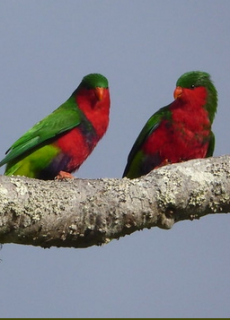Stephen’s Lorikeet |
|
|
Also known as: Henderson Island Lorikeet, Henderson Lorikeet
Photos
View in GalleryDid You Know?
Stephen's Lorikeet seems to have adapted to the presence of an introduced predator, the Pacific Rat (Rattus exulans).Academic Research
Related publications: Vini stepheniSpecies Profile
Genus: Vini | Species: stepheni
Size:
19cm (8 in)
Weight:
42-55g
Subspecies including nominate:
one
Colour Adult:
Both adults green upperparts, turning to yellow/green on rump and tail coverts; green crown and occiput, with elongated feathers streaked with paler green; red underparts; thighs and abdomen purple; green and purple band across chest that varies with individual; green underwing coverts marked with red; green/yellow tail. Bill deep orange. Eye yellow/orange.
Colour Juvenile:
Green underparts with purple and red marks on throat and abdomen; dark green tail. Bill brown. Eye brown.
Call:
Calls are soft and twittering while feeding. Louder notes are emitted while in flight.
Listen NowVideo Links:
Video 1 | Video 2More Information:
Content Sources:
CITES
BirdLife International
Cornell Lab of Ornithology/Birds of the World
A Guide to Parrots of the World, Juniper and Parr, 1998
xeno-canto XC97604, Mark, Todd, Henderson Island, Pitcairn Group, UK
Parrots: Status Survey and Conservation Plan 2000-2004, Snyder, McGowan, Gilardi, Grajal, 2000.
Parrots of the World, Forshaw, 2006. 2010 edition
Vanished and Vanishing Parrots, Forshaw, 2017.
Photos
View in GalleryDid You Know?
Stephen's Lorikeet seems to have adapted to the presence of an introduced predator, the Pacific Rat (Rattus exulans).Academic Research
Related publications: Vini stepheniSpecies Care
Captive Status:
Not found in captivity.
Longevity:
Not recorded.
Housing:
Not recorded.
Diet:
Not recorded.
Enrichment:
Not recorded.
Nest Box Size:
Not recorded.
Clutch Size:
Not recorded.
Incubation Time:
Not recorded.
Fledging Age:
Not recorded.
Hatch Weight:
Not recorded.
Peak Weight:
Not recorded.
Weaning Weight:
Not recorded.
Photos
View in GalleryDid You Know?
Stephen's Lorikeet seems to have adapted to the presence of an introduced predator, the Pacific Rat (Rattus exulans).Academic Research
Related publications: Vini stepheniSpecies Wild Status
World Population:
720-1820, presumably stable.
IUCN Red List Status:
Vulnerable
CITES Listing:
Appendix II
Threat Summary:
A BirdLife “restricted-range” species. This species is found only on one island, where the risk of harm from introduced species and diseases remains high.
Range:
Henderson Island, Pitcairn Group, S Pacific.
Habitat:
Found at about sea level on small raised-reef island in coconut palms along the beaches; also found throughout the low, dense forest that covers the interior.
Wild Diet:
Feeds on a variety of food types, including nectar and/or pollen from Scaevola sericea, Timonius polygamus, Cyclophyllum, Xylosma suaveolens, Thespesia populnea, Cordia subcordata, Psydrax, Senecio, Cocos nucifera and Pandanus tectorius, fruits of Eugenia rariflora, Nesoluma st-johnianum, Guettardia speciosa and Timonius polygamus, juice of Caesalpinia leaves, and butterfly or moth larvae from the spore case of Phymatosorus ferns.
Ecology and Behaviour:
Fairly conspicuous but more difficult to spot in dense foliage. Generally seen in small groups or families. Makes daily commutes from forest inland to coastal fringes to feed in coconut palms.
Clutch and Egg Size:
Not recorded.
Breeding Season:
April or May start.
Photos
View in GalleryDid You Know?
Stephen's Lorikeet seems to have adapted to the presence of an introduced predator, the Pacific Rat (Rattus exulans).Academic Research
Related publications: Vini stepheniMembers Only Resources
Please log-in now to find more research, resources and tools.
Not a Member?
Find more great information:
Gain exclusive access to 600+ pages of additional research, seminars and podcasts, specialists to ask your toughest questions, and dozens of other fun resources - when you become a WPT member.
Join Today >>

































